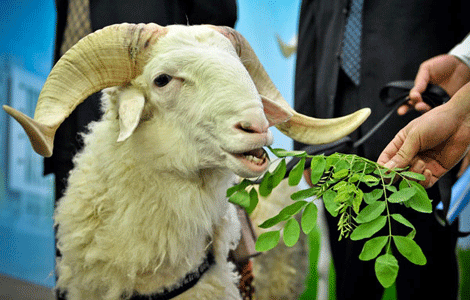
![Yu Huihuai, a farmer from Liaozhong county, Liaoning province, with his planting machinery. Yu's agricultural machinery cooperative provided machinery services for nearly 2,000 hectares of croplands last year. [WU YONG / CHINA DAILY] Cooperative sows seeds of hope for farmers](../../images/attachement/jpg/site1/20130201/00221917dead127538c503.jpg) |
|
Yu Huihuai, a farmer from Liaozhong county, Liaoning province, with his planting machinery. Yu's agricultural machinery cooperative provided machinery services for nearly 2,000 hectares of croplands last year. [WU YONG / CHINA DAILY] |
As most rural households prepare for the upcoming Spring Festival, 55-year-old Yu Huihuai is busy setting up another rice seeding greenhouse, which can serve 1,330 hectares of paddy field.
"I want to provide a modern seeding service for my fellow villagers. The service is cheaper than the traditional way and ensures a higher yield," Yu said.
Founded in 2008, Yu's agricultural machinery cooperative in Liaozhong county, Liaoning province, has 400 pieces of farm machinery and 926 members. Last year, nearly 2,000 hectares of croplands benefited from his cooperative and produced another harvest.
Yu's experience is the epitome of Liaoning's 10,000-plus farm cooperatives with 516,000 members who play important roles in improving grain output and farmers' incomes.
Zhu Lin, a political adviser with the provincial political advisory body, said the local government has input almost 46.9 million yuan ($7.51 million) to support farmer cooperatives.
Northeast China is a vital commodity grain production base of the country, contributing nearly 50 million metric tons per year, one-third of the nation's total.
However, the region's agriculture is restricted by traditional low earning and small-scale farming. Farmers usually have neither the capital nor motivation to improve mechanization and technology.
"A specialized agricultural machinery cooperative is an effective way to realize concentrated farming in this context. Also, the cooperative can make full use of the farm machinery's efficiency and help in improving the machines' utilization as well as reducing operating costs," said Ren Wentao, a professor of Shenyang Agricultural University.
According to the Liaoning Committee of Rural Economy, thanks to the introduction of high-quality seeds and mechanization, the past nine years have seen consecutive grain harvests. The total output of grains in 2012 was 207 million tons, 350,000 tons more than the previous year.
Cooperatives have played a vital role in purchasing modern agricultural production elements, said Ren. Moreover, the cooperative is good for increasing farmers' income.
The annual per capita income of cooperative members is 20 percent higher than non-members, according to the committee.
However, land transfers and financing obstacles still haunt China's farmers who strive for modernization.
The 670 hectares of farmland of Yu's cooperative are rented by more than 500 farmers in the county.
"I have to sign contracts with them every three to five years. Sometimes this is exhausting," Yu complained.
He suggests building a pilot program to allow land trades in Northeast China's main production area. In that case, intensification and mechanization can be realized and the output can be increased. Also, farmers will earn more money.
Although there are many difficulties, Yu is still optimistic about the future of his cooperative.
He plans to replace some old farming machinery with more advanced models to expand his business to surrounding villages.
"I have a dream that my fellow villagers can work like the people in the city. They can drive tractors, harvesters and even planes in grain production," Yu said with a bright smile.







